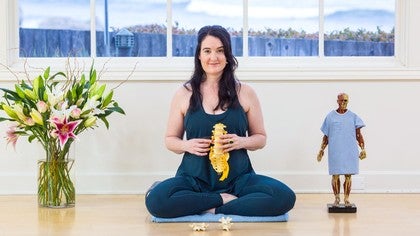Description
Please see attached .pdf below on Vertebrae and Disc Anatomy to assist you with this class.
About This Video
Transcript
Read Full Transcript
The gorgeous 24 individual vertebra that make up this vertebral chain all share some similarities. So let's look at first the lumbar vertebra. So each vertebra will have a vertebral arch made up of these three separate points. We have the spinous process. And these you can feel, if you move your hands to the back of your neck, you might feel those little bumps on the back of your neck.
Now they go all the way down, but because of flesh and where you can reach, the neck is a little bit more easily felt. Anything that's sharp and pointy is a great place for muscle and ligament attachment. So this will be a prime place for attachment of both muscles and ligaments. Then you have two little bumps that jut out to the sides. Now these you can also feel in your neck.
They're a little bit more lateral than you give them credit for, but if you take your hands to the sides of your neck and poke in and maybe turn your head a little bit side to side, you might feel those little lumps roll underneath your fingers. Now again you have them all the way down, but very hard to feel, except for in this more puny neck region. Now the vertebral arch, the negative space of that vertebral arch is the vertebral foramen. And foramen just means big hole. And so if you get a bunch of these big holes lining up, you make the vertebral canal and the special tissue of the spinal cord wrapped in these beautiful coverings or wrappers descends down through that vertebral canal.
Now on the other side we have the body of the vertebra. And you can see on the lumbar there's quite a big space for quite a big body, right, covering most of this region is where a lot of the weight will be dropped down, descending down and supported. It kind of looks like a big hard marshmallow. Now I'm going to cover this little hole with my finger, because that little hole is actually just where it sits on the stand at home, so you don't have to worry about that little hole. Now vertebra sit on one another at three points of contact.
I always think, again I'm from Ohio, so I'm not sure if you've ever seen a milking stool or on TV, it's just a real short stool with three legs. And so I always kind of think of this as 24 little milking stools stacked on one another. So they attach or articulate body to body. And then at these two pedicles, or these two feet, and so they have three points of contact. In between the two bones at those three points of contact, we'll also have something that's called an intervertebral disc.
Now the intervertebral disc is kind of analogous to a stale jelly donut. It's got a tough fibrous shell, kind of like the stale donut-y part, and a yummy jelly center, a squishy part. The outer shell is called the anillosis fibrosis, fibrous tissue, and the inside, the jelly goo, is called the nucleus propulsus. And just like an ice cream sandwich, it's squished in between the two bodies of a vertebra. When you have intervertebral disc, this type of fibrocartilage, everywhere down the vertebral chain from C2, or the second cervical vertebra, all the way down to L5, or the last lumbar vertebra.
Now if you take your hands and you pretend that you're squishing kind of a stale jelly donut in between your hands, if you were to take flexion of the spine, making the angle between the two bones more narrow, where's the jelly going to squish? It's going to squish back posterior towards you. If you take extension of the vertebra, where's the jelly going to be squished? Forward, anterior, same thing, lateral, squish to the side, lateral, squish to the side. Now if you do rotation of the vertebra, the jelly just kind of squishes towards the outside of the donut, just kind of squishes and spreads out inside of the fibrous donut shell.
All is well and good with this action, and it's actually how the disc maintains its health. It's called imbibition. After the age of 30, you no longer have direct blood supply to the inside of that disc, so they need to stay moist and springy and fluid, and so the way the body helps that along is by movement, and it's not just twist. Sometimes we hear that in a yoga practice, twists are what's going to help keep your spine and your disc healthy. It's any movement.
It's flexion, extension, lateral flexion. It's any dance move that you can think of. Anything, any movement is really how these discs maintain their health. Every time, it's almost like if you have a dirty sponge and it gets all kind of dried out on your sink, you can tell it gets kind of brittle and gross and doesn't work so well, but if you put it on a puddle of water, it kind of slurps up the water, plumps up, and it gets more pliable and more juicy. Now sometimes things go awry in the disc.
There's some different types of disc pathologies. So if we look at this model of the five lumbar vertebrae and the sacrum, you can see inside we've got the descending of the spinal cord, and then on the outside where these little nerve roots exit in between the two vertebrae are unfortunately sometimes right in the path of when a disc goes wrong, when a disc goes awry. Sometimes that jelly can do what's called a bulging disc you might have heard of. So if I'm a disc, the jelly is going to kind of poke its head a little bit out of the disc. Or it's a herniated disc where it goes and splurts out of the disc itself.
So here we can see a bulging disc, and it's bulging slightly lateral, slightly posterior, which unfortunately puts it right in the path of this nerve root. And when the nerve root gets pressed upon, ouch, radiating, traveling, sharp shooting pain, sometimes called a radiculopathy, a pathology of the nerve root, or radical, and that causes this kind of nerve pain that some of us unfortunately are familiar with. Now if the disc moves in a different path, moves more anterior in nature, slightly away from the head of these little radicals, you might not ever be aware of it. In fact, if you're past the age of 30, which a lot of us are, this is what's considered advanced age in a lot of anatomy books or in the medical community. It's a tough go, luckily we get smarter and cuter, but our soft tissues of the body do start to degrade.
Now that's not a problem, this is just the nature of this yin and yang, or this rajas and talmas in the body, but it makes our disc a little bit more prone to injuries. Good news, they've done these studies where they throw these, they don't throw them, but they place these people in these MRI machines where they can see inside, and the older population, say a population in their 80s, 80% of those that are scanned will show some kind of soft tissue damage, so a torn rotator cuff, a labrum tear, a disc herniation, something like that, but they are asymptomatic, which means they don't have any problems. So there has to be something else involved besides the kind of death and destruction of our tissues, whether it's the muscular health and support, whether it's nutrition, whether it's something else like social contact or mental health, all contribute to the health and functioning of your body. So in the next few episodes, I'd like to take you through not the similarities, but the differences in each segment so we can use parts of the body for what they're good for and not ask them to do things that aren't on their body resume.
Your Body on Yoga: Torso
Comments
You need to be a subscriber to post a comment.
Please Log In or Create an Account to start your free trial.














